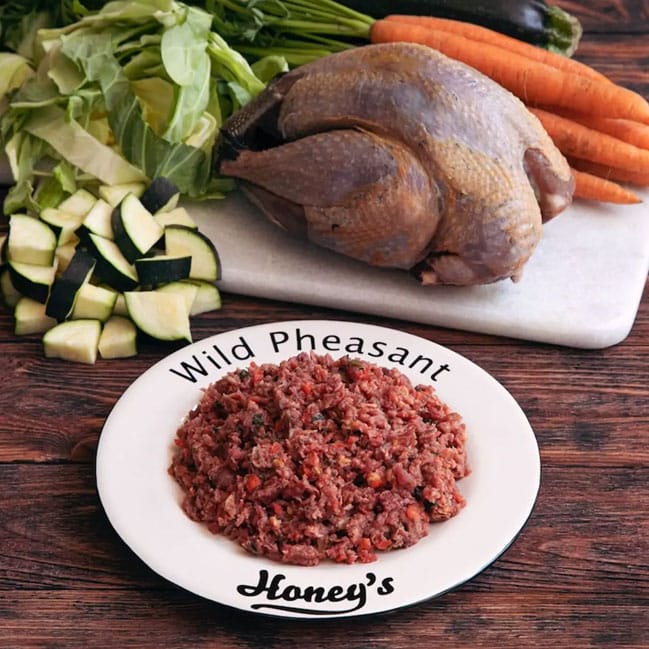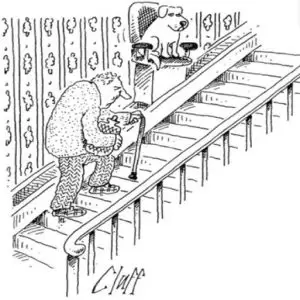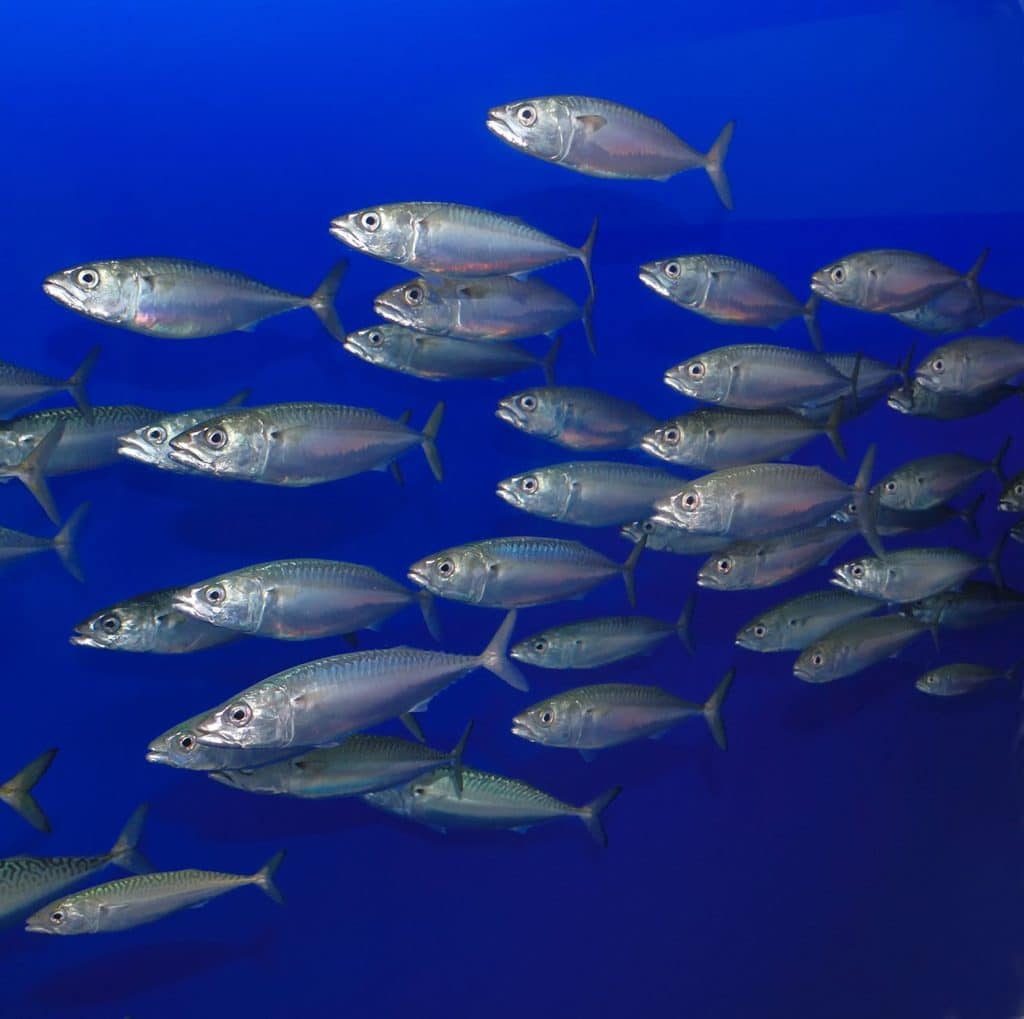In an ideal world we would probably only feed our dogs wild, locally sourced meat. There are lots of reasons for this, starting with the fact that the animals and birds involved have led natural lives and have eaten a natural diet. They haven’t been given routine doses of antibiotics or other drugs, either. Nor have they been caged. Best of all, wild meats come closest to a dog’s species appropriate diet. However, wild meat is becoming increasingly difficult to source and correspondingly expensive. Nevertheless, we still offer venison, a limited amount of rabbit and pheasant.
One of my favourite game options is pheasant. Recently, there have been a number of highly misleading media reports warning against pheasant based on a piece of poorly carried out research. This article explains why (if you feed pheasant sourced by Honey’s) you can ignore the research and the adverse publicity it generated. But first I just want to emphasise why pheasant is so good for your dog:
- Wild pheasants get plenty of fresh air and exercise (they can run at up to 45 mph!) and live on a natural diet of seeds, grains, roots, berries, fresh green shoots and insects.
- Wild pheasant provides a highly nutritious meat packed full of B Vitamins (which regulate metabolism and hormones), Vitamin C (which reduces inflammation), Vitamin A (which supports vision in dogs), Vitamin E (which is vital for eyes, muscles and reproductive organs), Potassium (great for muscle and nerve function), Omega 3 (beneficial for arthritis in dogs, kidney disease, and brain development), Zinc (which aids immunity), Selenium (which helps prevent disease improves fertility and Antioxidants (which is vital for healthy skin and a shiny coat).
In short, pheasant offers many benefits to dogs, such as supporting muscle growth and function and immune system, eye health and cognitive function. It is a lean protein, too, which means it is great for dogs that need to keep their fat levels down.
So, why the fuss?
On the 3rd of May 2023, a study, Lead concentrations in commercial dog food containing pheasant in the UK was published leading to lots of (ignorant, sensational and stupid) newspaper headlines about how pheasant is not safe for dogs to eat. Although the research really wasn’t relevant to what we offer at Honey’s, it did serve as a good excuse to explain and update our ingredients policy as it relates to pheasant.
Honey’s policy on pheasant
At Honey’s we offer four game recipes: Wild Venison, Wild Game, Wild Pheasant, and Wild Rabbit. All are in short supply and when we do have stock we share it out, prioritising customers with dogs who require one or other of the recipes for medical reasons (perhaps due to an allergy or health reasons).
The reason we have so little stock is that we have terrible trouble finding game that meets our ethical and environmental standards at a price that is affordable.
Only two of our recipes contain pheasant and our two suppliers are aware that it is against our policy to purchase birds that have been shot with lead ammunition. Indeed, both are completely committed to using lead-free ammunition and promise that only a miniscule percentage, if any, of the birds they handle have been shot with lead.
Why could it even happen at all? Apparently on small shoots the odd participant with an antique gun (not converted for use with non-lead ammunition) or old ammunition may participate and break the rules without the organisers being aware of it. So, I can’t absolutely guarantee our pheasant has been shot with non-lead ammunition, but I can 99.99999% guarantee it. Moreover, within a very short period I believe we will have eradicated even this extremely slim chance.
I should add that we inspect all the pheasants we use and Guy, our Head of Production, says that in the ten years he has been with Honey’s he can count on one hand the number of times we have found any shot at all.
To summarise:
- We are opposed to the use of lead ammunition for environmental and health reasons and we have written to our MP about this several times.
- Our game suppliers are equally committed to lead-free ammunition.
- We advise our game suppliers that we will not knowingly purchase pheasant (or anything else) that has been killed using lead ammunition.
- We inspect all pheasants that we do purchase for ammunition so that we can remove it before turning it into food. It is very, very rare to find any at all.
- We are as close to 100% certain that our pheasant has not been shot with lead ammunition as it is possible to be.
The irrelevant research
Lead concentrations in commercial dog food containing pheasant in the UK was carried out by five highly qualified scientists – Deborah J. Pain (Department of Zoology, Cambridge), Rhys E. Green (as Pain) Nicola Bates (Veterinary Poisons Information Service) , Maider Guiu (Environmental Research Institute, University of the Highlands and Islands) and Mark A Taggart (as Guiu) – and immediately attracted a great deal of media interest with headlines such as ‘Dogs face risk of deadly lead poisoning from pheasant meat in pet food (Sky News) and ‘Pet dogs face risk of deadly lead poisoning from pheasant’ (Independent).
My main criticism of the research is that although almost a third of UK dog food manufacturers (apparently) offer pheasant recipes, the researchers only analysed food from two raw food producers (three recipes in total and 90 individual packages). They also analysed two air dried products and one tinned product. I would question whether this is statistically viable. All food varies dramatically from batch to batch but none more so than artisan produced food using wild ingredients. Yes, of course, it is useful to take a small sample and see what one discovers but to get a real picture you need to look at a much larger number of producers, many more recipes and a wider range of batches.
Anyway, my read of the research is that in 10% of the minced (raw) samples there was a high concentration of lead, and this was because they found whole lead shot. In other words, 90% of the food had a very low concentration because it had no whole lead shot in it. Had the pheasant been inspected before production (which is what we do at Honey’s) much less shot would have been present. This is the relevant part of the research findings (the bold text is my addition):
‘Repeat X-ray of minced pheasant packages (products PM1, PM2, PM3) from which samples had the 14 highest lead concentrations showed that two shot remained in one milled sample and a single shot remained in eight samples. The remaining five samples contained no shot, nor did any of the 12 samples selected from the 76 packages in the lower lead concentration group (Fig. 2). The mean lead concentration in the five high-lead samples with no shot was 3 368.59 ppm d.w. The 12 samples randomly selected from the lower concentration group had a mean lead concentration of 13.92 ppm d.w. We assumed that all 76 low- concentration samples contained no shot and had the same mean lead concentration. The weighted mean for all samples known or assumed to contain no lead shot was therefore (76 × 13.92 + 5 × 3 368.59)/81, i.e. 220.99 ppm d.w. with 95% confidence limits of 78.84 – 421.14 ppm d.w. calculated using a bootstrap procedure (Appendix 10% (9/90) of the minced pheasant samples had very much higher S2). We conclude that lead concentrations than the remaining 90% of samples because of the presence of lead shot in the sample.‘
So, when the study announces dramatically, that the ‘mean lead concentration was surprisingly high’ they are comparing two very different situations: food with whole lead shot and food without whole lead shot. Another interesting conclusion was that ‘the lowest mean lead concentration was found in the raw pheasant product containing the highest proportion of bone.’ As an aside, we include bone in our game recipes so even if we were accepting pheasant shot with lead (which we aren’t) and even if we didn’t inspect it (which we do) it would clearly contain much lower levels of lead.
A further point of interest. Most dog food producers use what is called ‘Category 3’ material i.e., ingredients that are not suitable for or intended for the human food chain. At Honey’s, of course, we only use fresh ingredients that would, if we weren’t using them in our dog food, be 100% suitable for human consumption. Pheasant prepared for human consumption has a much lower chance of having any shot (never mind lead shot). Incidentally, no one really knows what a safe or dangerous level of lead is for dogs – as the researchers themselves acknowledge.
To summarise
Dogs love wild pheasant and with good reason. It is their natural prey and it is absolutely packed full of nutrition. If you serve Honey’s pheasant you can be certain that it will be lead free and so you can ignore all the sensational headlines stating that it is dangerous to feed pheasant to dogs. Far from being dangerous, it is one of the best possible ingredients you could give them.
Article by Jonathan Self.



